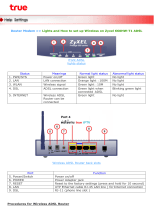
i
Contents
1 Introduction ........................................................................................................1
1.1 Safety Precautions ................................................................................1
1.2 LEDs and Interfaces..............................................................................2
1.3 System Requirements...........................................................................4
1.4 Features ................................................................................................4
2 Hardware Installation .........................................................................................5
3 About the Web Configuration.............................................................................8
3.1 Access the Router.................................................................................8
3.2 Status.....................................................................................................8
3.2.1 Device Info..................................................................................9
3.2.2 System Log.................................................................................9
3.2.3 Statistics....................................................................................10
3.3 Quick Start...........................................................................................11
3.4 Interface Setup....................................................................................15
3.4.1 Internet......................................................................................15
3.4.2 LAN...........................................................................................24
3.4.3 Wireless....................................................................................27
3.5 Advanced Setup..................................................................................29
3.5.1 Firewall .....................................................................................30
3.5.2 Routing .....................................................................................30
3.5.3 NAT...........................................................................................31
3.5.4 QoS...........................................................................................36
3.5.5 VLAN ........................................................................................39
3.5.6 ADSL ........................................................................................42
3.6 Access Management...........................................................................42
3.6.1 ACL...........................................................................................42
3.6.2 Filter..........................................................................................43
3.6.3 SNMP .......................................................................................47
3.6.4 UPnP ........................................................................................47
3.6.5 DDNS........................................................................................48
3.7 Maintenance........................................................................................49
3.7.1 Administration...........................................................................49
3.7.2 Time Zone.................................................................................50
3.7.3 Firmware...................................................................................51

























